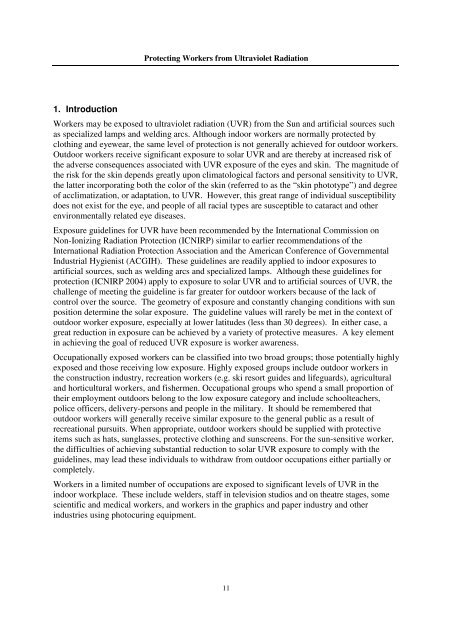Protecting Workers from Ultraviolet Radiation - icnirp
Protecting Workers from Ultraviolet Radiation - icnirp
Protecting Workers from Ultraviolet Radiation - icnirp
Create successful ePaper yourself
Turn your PDF publications into a flip-book with our unique Google optimized e-Paper software.
1. Introduction<br />
<strong>Protecting</strong> <strong>Workers</strong> <strong>from</strong> <strong>Ultraviolet</strong> <strong>Radiation</strong><br />
<strong>Workers</strong> may be exposed to ultraviolet radiation (UVR) <strong>from</strong> the Sun and artificial sources such<br />
as specialized lamps and welding arcs. Although indoor workers are normally protected by<br />
clothing and eyewear, the same level of protection is not generally achieved for outdoor workers.<br />
Outdoor workers receive significant exposure to solar UVR and are thereby at increased risk of<br />
the adverse consequences associated with UVR exposure of the eyes and skin. The magnitude of<br />
the risk for the skin depends greatly upon climatological factors and personal sensitivity to UVR,<br />
the latter incorporating both the color of the skin (referred to as the “skin phototype”) and degree<br />
of acclimatization, or adaptation, to UVR. However, this great range of individual susceptibility<br />
does not exist for the eye, and people of all racial types are susceptible to cataract and other<br />
environmentally related eye diseases.<br />
Exposure guidelines for UVR have been recommended by the International Commission on<br />
Non-Ionizing <strong>Radiation</strong> Protection (ICNIRP) similar to earlier recommendations of the<br />
International <strong>Radiation</strong> Protection Association and the American Conference of Governmental<br />
Industrial Hygienist (ACGIH). These guidelines are readily applied to indoor exposures to<br />
artificial sources, such as welding arcs and specialized lamps. Although these guidelines for<br />
protection (ICNIRP 2004) apply to exposure to solar UVR and to artificial sources of UVR, the<br />
challenge of meeting the guideline is far greater for outdoor workers because of the lack of<br />
control over the source. The geometry of exposure and constantly changing conditions with sun<br />
position determine the solar exposure. The guideline values will rarely be met in the context of<br />
outdoor worker exposure, especially at lower latitudes (less than 30 degrees). In either case, a<br />
great reduction in exposure can be achieved by a variety of protective measures. A key element<br />
in achieving the goal of reduced UVR exposure is worker awareness.<br />
Occupationally exposed workers can be classified into two broad groups; those potentially highly<br />
exposed and those receiving low exposure. Highly exposed groups include outdoor workers in<br />
the construction industry, recreation workers (e.g. ski resort guides and lifeguards), agricultural<br />
and horticultural workers, and fishermen. Occupational groups who spend a small proportion of<br />
their employment outdoors belong to the low exposure category and include schoolteachers,<br />
police officers, delivery-persons and people in the military. It should be remembered that<br />
outdoor workers will generally receive similar exposure to the general public as a result of<br />
recreational pursuits. When appropriate, outdoor workers should be supplied with protective<br />
items such as hats, sunglasses, protective clothing and sunscreens. For the sun-sensitive worker,<br />
the difficulties of achieving substantial reduction to solar UVR exposure to comply with the<br />
guidelines, may lead these individuals to withdraw <strong>from</strong> outdoor occupations either partially or<br />
completely.<br />
<strong>Workers</strong> in a limited number of occupations are exposed to significant levels of UVR in the<br />
indoor workplace. These include welders, staff in television studios and on theatre stages, some<br />
scientific and medical workers, and workers in the graphics and paper industry and other<br />
industries using photocuring equipment.<br />
11



